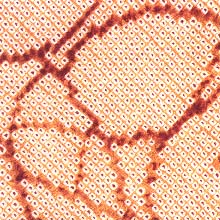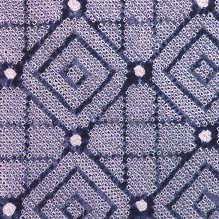Dye (p. 105 )
1. Produced in Kyoto City, Kyoto-Fu.
2. Characteristics: A tiny pointed tie dye, regarded as the highest class tie dye
3. Uses: Clothing, sashes.
4. History: The tie dye has a long history originating in China from where it was imported. The origin was "Kokechi," one of the "Three Press Dyes in Tenpyo(729-748)," that is, "Kyokechi"(plate dye), "Kokechi"(tie dye) and "Rokechi"(batik). The tie dyed fabrics from the Asuka Period(593-710) are stored at Horyuji Temple and those from the Nara Period(710-794) are at the Shosoin(Imperial Treasure House) in Nara Prefecture. In much later years, "Tsujigahana" was produced towards the end of the Muromachi Period and became very popular in the Edo Period. These tie dyed fabrics were widely used not only for clothing but also for "Tegara"(chignon band), sashes and undershirts. Although the Tokugawa Shogunate enacted sumptuary laws several times the use of bright and gorgeous "Kanoko,"production has not been disrupted until today."Kanoko Shibori" was first used as sash bustle after WWII. Most of the tying jobs are done in Korea today due to manpower shortage in Japan.
Dyeing Method
1. A sketch is drawn with "Aobana"(juice from the flower of "Murasaki Tsuyukusa," dayflower, Commelina communis).
2. Points are picked up with a needle and tied with silk threads several times. The difference in the amount of the area to be picked up and the number of tying points bring about varieties of "Kanoko" such as "Hitta Kanoko,""Kyogoku Kanoko" and "Hitome Shibori."
3. The number of points tied ranges from 45 to 70 in one "Shaku"(about 30cm). 8,000 to 9,000 points are tied for "Hekoobi"(soft sash, a cloth with 36-38 cm width and 380 cm length), and some 250,000 points for Kimono cloth(usual size of which is 36-38 cm width and 985 cm length).
4. The cloth is dip dyed, dried, and the thread removed and then steamed.




